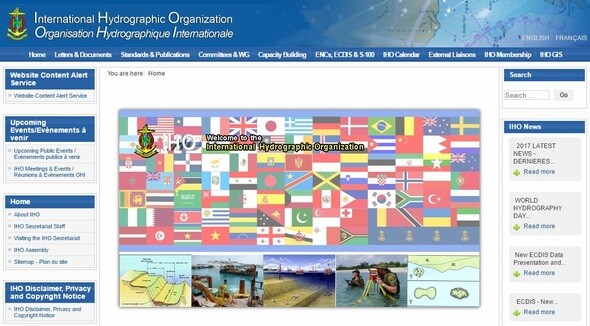hankyoreh
Links to other country sites 다른 나라 사이트 링크
South Korea and Japan set to joust again over use of “East Sea”

South Korea and Japan’s diplomatic war over use of the term “East Sea” rather than “Sea of Japan” in international standard nautical charts is reigniting after five years. On Apr. 24, the South Korean Ministry of Foreign Affairs announced that the 19th International Hydrographic Organization (IHO) assembly was taking place through Apr. 28 in Monaco. The assembly is expected to see fierce diplomatic campaigns by South Korea and Japan over amendment of the IHO’s nautical chart publication “Limits of Oceans and Seas” (S-23) and related listings using the name “East Sea.” S-23, which serves as a reference standard when publishing nautical charts, has listed the East Sea as the “Sea of Japan” since its first publication in 1929.
The South Korean government first asserted use of the East Sea name alone as its basic position at the 1997 IHO assembly, stating that the two names “East Sea” and “Sea of Japan” could be used side by side until an agreement was reached with Japan. Since then, the assemblies, which are held every five years, have been the setting for tense disputes between the South Korean government, with its calls for the East Sea label, and the Japanese government, which calls for using the Sea of Japan name alone.
The IHO makes its rulings by majority vote from a quorum of sitting representatives, but its preference for unanimous agreement over voting has led to delays in amendment of its chart collection. On the East Sea issue in particular, member countries are strongly in favor of a consensus between the two sides. No amended edition of the chart collection has been produced since 1953.
For the latest assembly, the South Korean government sent a delegation of 30 or so experts from the Ministry of Foreign Affairs, Ministry of Oceans and Fisheries, Navy, Korea Hydrographic and Oceanographic Administration, and Northeast Asian History Foundation. But differences with Japan remain strong enough that an amendment during the current assembly is seen as unlikely.
“Due to Japan’s uncompromising stance, we are having trouble reaching an agreement,” said a senior government official.
“We plan to commit maximum energy to ensuring that the East Sea name is used,” the official added.
The South Korean government is putting its weight behind the public relations campaign in the belief that the efforts will help boost the percentage of civilian map-makers using the East Sea label. Indeed, the percentage of international maps using the East Sea name alone or along with “Sea of Japan” reportedly increased from less than 3% in the early ’00s to 28% by 2009.
By Kim Ji-eun, staff reporter
Please direct questions or comments to [english@hani.co.kr]

Editorial・opinion
![[Column] How tragedy pervades weak links in Korean labor [Column] How tragedy pervades weak links in Korean labor](https://flexible.img.hani.co.kr/flexible/normal/500/300/imgdb/original/2024/0703/8717199957128458.jpg) [Column] How tragedy pervades weak links in Korean labor
[Column] How tragedy pervades weak links in Korean labor![[Column] How opposing war became a far-right policy [Column] How opposing war became a far-right policy](https://flexible.img.hani.co.kr/flexible/normal/500/300/imgdb/original/2024/0702/5017199091002075.jpg) [Column] How opposing war became a far-right policy
[Column] How opposing war became a far-right policy- [Editorial] Korea needs to adjust diplomatic course in preparation for a Trump comeback
- [Editorial] Silence won’t save Yoon
- [Column] The miscalculations that started the Korean War mustn’t be repeated
- [Correspondent’s column] China-Europe relations tested once more by EV war
- [Correspondent’s column] Who really created the new ‘axis of evil’?
- [Editorial] Exploiting foreign domestic workers won’t solve Korea’s birth rate problem
- [Column] Kim and Putin’s new world order
- [Editorial] Workplace hazards can be prevented — why weren’t they this time?
Most viewed articles
- 1South Koreans living near border with North unnerved by return of artillery thunder
- 2Car behind deadly crash began rapid acceleration after exiting underground garage
- 3S. Korea “monitoring developments” after report of secret Chinese police station in Seoul
- 4Democrats ride wave of 1M signature petition for Yoon to be impeached
- 510 days of torture: Korean mental patient’s restraints only removed after death
- 6Families, friends mourn loved ones cut down in prime in deadly car crash
- 7[Column] How tragedy pervades weak links in Korean labor
- 8Hyundai Motor sets up one-stop shop for EV production in Indonesia
- 9Samsung barricades office as unionized workers strike for better conditions
- 10[Column] The miscalculations that started the Korean War mustn’t be repeated